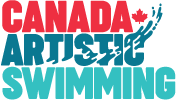Overview
Canada’s ‘dynamic duet’ outside the pool and at the FINA table, continues to provide strong leadership internationally. Lisa Schott, reappointed to the FINA SY Technical Committee (TSSC) for another four years now as Chair, was instrumental in the creation of the FINA Synchronized Swimming World Series and is championing the inclusion of males in the sport in support of IOC gender equity initiatives. Synchro Canada is confident that Schott will continue to lead the TSSC in a significant and innovative way in its role to shepherd and grow the re-branded sport of Artistic Swimming into the next quadrennial.
Aquatics Canada Board member, Dr. Margo Mountjoy, was re-elected as a member of the FINA Bureau. Mountjoy’s leadership in the areas of Swim For All, Swim For Life, anti-doping, as well as respect in sport, and eating/nutrition for athletic performance and many other healthy sport participation programs on behalf of FINA is exemplary. She will continue to liaise for the Bureau in the broad and important area of sport medicine.
Synchro Canada took a leadership role in assessing the sport’s rules, submitting many important and meaningful amendment proposals to TSSC (TASC) for this next Congress. Notable in these proposals is one for the competition handbook where federations are encouraged to try new judging systems providing they follow FINA guidelines. This would allow for the creativity of members to continue to drive the development of the judging system to effectively measure the ever- improving performance of athletes.
Additionally, Aquatics Canada took leadership in nominating a number of Canadians for various FINA committees and commissions. The list of successful applicants is included below:
| NAME | POSITION |
| FELTHAM, Aaron | Athlete Committee – Water Polo |
| OLIVERIA, Justin | Coach Commission – Water Polo |
| DZIVER, Aaron | Coach Commission – Diving |
| CROXON, Sheilagh | Coach Commission – Artistic Swimming |
| FRANCIS, Eddie | Finance Committee member |
| LECH, David | Doping Panel member |
| SCHOTT, Lisa | Synchro (Artistic Swimming) Committee Chair |
| SHAW, Bill | Water Polo Committee member |
| SEAMAN, Kathy | Diving Committee Honorary Secretary |
| LEBLANC, Louise | Swimming Committee member |
| GELLER, Mitch | High Diving Committee member |
| EVELLY, Ed | Masters Committee Honorary Secretary |
Synchro Canada will continue to be a strong advocate for synchronized/artistic swimming and a supporter of FINA programming and was proud to be selected as a host of one of the inaugural FINA World Series of Synchronized Swimming this past spring.
Included below is a summary of rule and bylaw changes passed at the FINA Technical and General Congress.
A) Technical Congress for Synchronised Swimming
- Introduction of a new event in the programme of the FINA World Championships: the Highlight Routine (with 10 swimmers). Required elements (to be performed by all athletes) for this routine include a minimum of four acrobatic movements (jumps, throws, lifts, stacks or platforms), a connected or intertwined action, and a float to give a kaleidoscopic effect;
- Figures are replaced by technical routines at FINA World Junior Synchronised Swimming Championships (commencing in 2018);
- Free team routines may have a maximum of six acrobatic movements (excluding partner lifts). If this number is exceeded, a two-point penalty shall be deducted from the routine score;
- Reduction of the Free Combination routine time, from 4m30s to 4m00s
- Changes in the judgement of figures, with definitions for small, medium and large deductions;
- For Solo and Duet technical routines, all elements shall be performed parallel to the sides of the pool where the panel of judges have been placed;
- Update on the rules concerning the music accompaniments;
- Adjustments on some synchro movements.
B) FINA General Congress
- Elections
In the presence of delegates from 176 National Federations, the FINA General Congress took place in Budapest (HUN). The national bodies’ representatives voted the new FINA Bureau for the period 2017-2021, as follows:
| Position | Name |
| President | Dr Julio C. Maglione (URU) |
| Honorary Treasurer | Pipat Panjangvait (THA) |
| First Vice-President | Husain Al Masallam (KUW) |
| Second Vice-President | Sam Ramsamy (RSA) |
| Vice-Presidents | |
| Dale Neuburger (USA) | |
| Paolo Barelli (ITA | |
| Dennis Miller (FIJ) | |
| Members | |
| Dr Mohamed Diop (SEN) | Tamas Gyarfas (HUN) |
| Mario Fernandes (ANG) | Zouheir El Moufti (MAR) |
| Dr Donald Rukare (UGA) | Matthew Dunn (AUS) |
| Dr Margo Mountjoy (CAN) | Errol Clarke (BAR) |
| Algernon Cargill (BAH) | Juan Carlos Orihuela Garcete (PAR) |
| Daichi Suzuki (JPN) | Jihong Zhou (CHN) |
| Andrey Kryukov (KAZ) | Taha Al Kishry (OMA) |
| David Sparkles (GBR) | Vladimir Salnikov (RUS) |
| Dimitris Diathesopoulos (GRE) | Erik van Heijningen (NED) |
- Rule Changes
Moreover, the FINA General Congress approved the following main changes in the FINA rules:
a) Constitution
- Change of the name of “synchronised swimming” to “artistic swimming” (see c) below);
- Creation of a FINA Second Vice-President and definition of respective duties;
- Transfer of former Honorary Secretary’s duties to the Executive Director;
- Change of the timing for the General Congress, now to be organised every two years (instead of four) on the occasion of the FINA World Championships. However, election Congress continues to take place every four years;
- Election of Ethics Panel and Audit Committee (a new body) by the General Congress;
- The FINA Bureau will consist of 25 voting members (instead of 23);
- Enlargement in the number of Bureau members elected at large from Africa (7 to 8) and from Asia (1 to 2);
- New composition and duties of the FINA Executive, composed by the President, First Vice-President, Second Vice-President, Honorary Treasurer, three Vice-Presidents and one member to be nominated by the President to ensure continental representation;
- Bureau members can be elected for a maximum of three full terms. This rule also applies to the President, irrespective of terms served before as member;
- Redefinition of the Bureau duties;
- New composition of the FINA Coaches Committee, consisting of up to 24 members, which will form six sub-committees for each of the aquatic disciplines;
- Update on the Finance Committee and Ethics Panel duties;
- Creation of a Chief Internal Audit Officer.
- Update on the sport nationality rules;
- Besides tobacco and alcohol, advertising for sports-related betting is now also prohibited;
- Redefinition of the FINA events’ programme at the Olympic Games.
- Updates on technical aspects of the Facilities Rules were also approved and relate with swimming, diving, water polo pools, and sound equipment standards.
c) Rationale for Support for Name Change to Artistic Swimming
- An attempt is being made by the International Olympic Committee (IOC) to group artistic / judged sports together and the initial suggestion for change came from that body. This provides some security for the sport of synchronized swimming not only as part of the aquatics family, but also part of another group of sports solidly entrenched in the Olympic programme – in particular, the alignment with Artistic Gymnastics is a reasonable and positive one.
- In terms of marketing the sport, and strengthening its brand worldwide, the alignment of synchronized swimming with other judged sports makes good business sense and will allow for increased understanding by spectators – Synchro Canada sees this as an opportunity to grow the sport’s reputation and identity – and a chance to accomplish some needed structure development within the sport
- In terms of fair representation of the sport, “synchronized” refers only to one aspect of the skills required for excellence, and does not fully represent the depth and breadth of incredible athletic performance capacity and artistic qualities of its current participating athletes
- There is no requirement for National Federations to change their names within a specific timeframe – many FINA Members have language issues to contemplate and FINA has not yet communicated the process it will follow in adopting the name change on a practical level
- Synchro Canada will begin discussions now about how this change will affect our brand in the short and long term and will work closely with Members and clubs to determine next steps related to the name change before taking any action.


